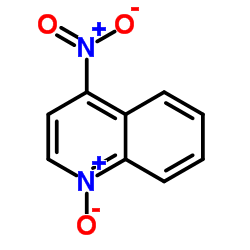4-Nitroquinoline 1-oxide

4-Nitroquinoline 1-oxide structure
|
Common Name | 4-Nitroquinoline 1-oxide | ||
|---|---|---|---|---|
| CAS Number | 56-57-5 | Molecular Weight | 190.16 | |
| Density | 1.4±0.1 g/cm3 | Boiling Point | 387.6±34.0 °C at 760 mmHg | |
| Molecular Formula | C9H6N2O3 | Melting Point | 154-156 °C(lit.) | |
| MSDS | Chinese USA | Flash Point | 188.2±25.7 °C | |
| Symbol |

GHS08 |
Signal Word | Danger | |
|
Rad23 interaction with the proteasome is regulated by phosphorylation of its ubiquitin-like (UbL) domain.
J. Mol. Biol. 426(24) , 4049-60, (2014) Rad23 was identified as a DNA repair protein, although a role in protein degradation has been described. The protein degradation function of Rad23 contributes to cell cycle progression, stress response, endoplasmic reticulum proteolysis, and DNA repair. Rad23... |
|
|
DNA damage-specific deubiquitination regulates Rad18 functions to suppress mutagenesis.
J. Cell Biol. 206(2) , 183-97, (2014) Deoxyribonucleic acid (DNA) lesions encountered during replication are often bypassed using DNA damage tolerance (DDT) pathways to avoid prolonged fork stalling and allow for completion of DNA replication. Rad18 is a central E3 ubiquitin ligase in DDT, which ... |
|
|
Genotoxicity testing of esterified propoxylated glycerol (EPG).
Regul Toxicol Pharmacol 70 Suppl 2 , S131-42, (2014) Four versions of esterified propoxylated glycerols (EPGs) were evaluated for potential genotoxicity using a range of in vitro and in vivo assays. H-EPG-05 HR/SO 9:1, H-EPG-05 soyate, and H-EPG-14 soyate were non-mutagenic in reverse mutation assays (maximum c... |
|
|
Cmr1/WDR76 defines a nuclear genotoxic stress body linking genome integrity and protein quality control.
Nat. Commun. 6 , 6533, (2015) DNA replication stress is a source of genomic instability. Here we identify changed mutation rate 1 (Cmr1) as a factor involved in the response to DNA replication stress in Saccharomyces cerevisiae and show that Cmr1--together with Mrc1/Claspin, Pph3, the cha... |
|
|
Mechanistic evaluation of Ginkgo biloba leaf extract-induced genotoxicity in L5178Y cells.
Toxicol. Sci. 139(2) , 338-49, (2014) Ginkgo biloba has been used for many thousand years as a traditional herbal remedy and its extract has been consumed for many decades as a dietary supplement. Ginkgo biloba leaf extract is a complex mixture with many constituents, including flavonol glycoside... |
|
|
In Vitro Safety/Protection Assessment of Resveratrol and Pterostilbene in a Human Hepatoma Cell Line (HepG2).
Nat. Prod. Commun. 10 , 1403-8, (2015) The aim of this work was to evaluate in vitro the genotoxic and/or antigenotoxic effects of resveratrol (RESV) and pterostilbene (PTER) on HepG2 cells. Moreover, additional tests were performed to evaluate early and late apoptosis events induced by the tested... |
|
|
Toxicogenetic effects of low concentrations of the pesticides imidacloprid and sulfentrazone individually and in combination in in vitro tests with HepG2 cells and Salmonella typhimurium.
Ecotoxicol. Environ. Saf. 120 , 174-83, (2015) The insecticide imidacloprid and the herbicide sulfentrazone are two different classes of pesticides that are used for pest control in sugarcane agriculture. To evaluate the genotoxic potential of low concentrations of these two pesticides alone and in mixtur... |
|
|
Genotoxic properties of representatives of alkylindazoles and aminoalkyl-indoles which are consumed as synthetic cannabinoids.
Food Chem. Toxicol. 80 , 130-6, (2015) Synthetic cannabinoids (SCs) cause similar effects as cannabis and are sold in herbal mixtures. Recent investigations indicate that some of these drugs possess genotoxic properties. Therefore, we tested representatives of two groups, namely, aminoalkylindoles... |
|
|
Safety assessment of dietary bamboo charcoal powder: a 90-day subchronic oral toxicity and mutagenicity studies.
Food Chem. Toxicol. 75 , 50-7, (2015) Vegetable carbon has been used as food additive in EU (E153) and China for many years; however, no experimental data have been available on its dietary safety. This study was designed to evaluate the subchronic toxicity and genotoxicity of bamboo charcoal pow... |
|
|
Genotoxic, Cytotoxic, Antigenotoxic, and Anticytotoxic Effects of Sulfonamide Chalcone Using the Ames Test and the Mouse Bone Marrow Micronucleus Test.
PLoS ONE 10 , e0137063, (2015) Chalcones present several biological activities and sulfonamide chalcone derivatives have shown important biological applications, including antitumor activity. In this study, genotoxic, cytotoxic, antigenotoxic, and anticytotoxic activities of the sulfonamid... |